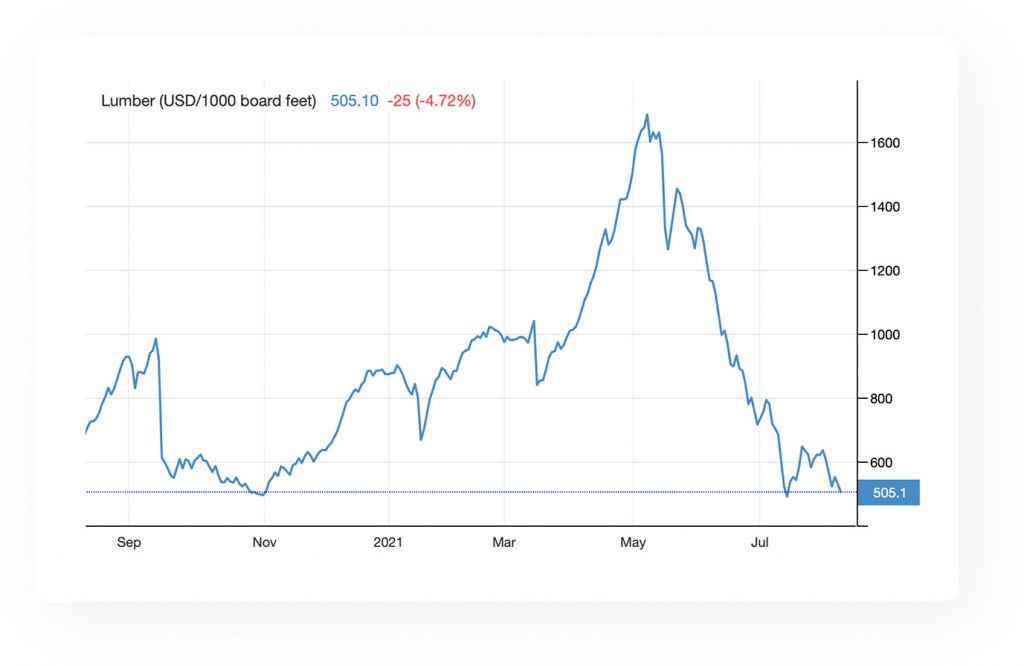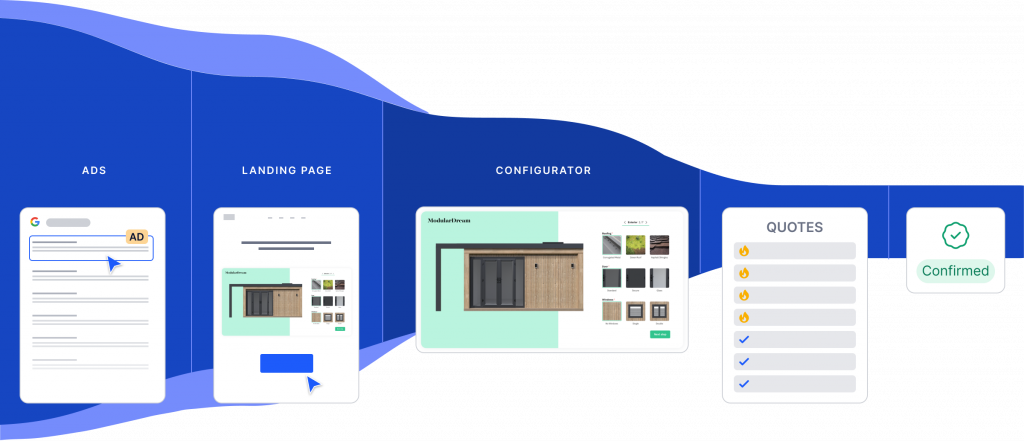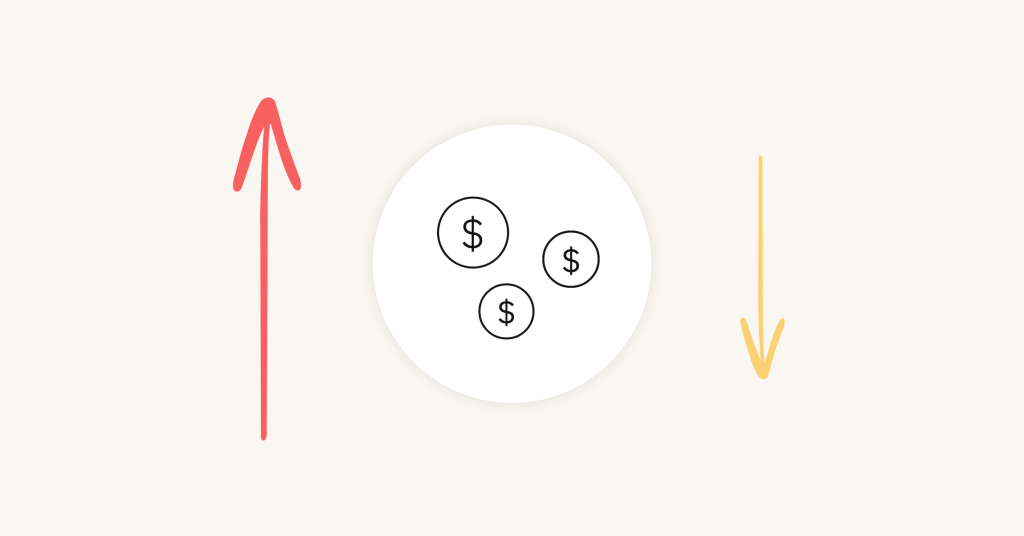In any large company, keeping your team up to speed with product costs is a constant challenge. The bigger your team, the harder it becomes, especially with costs changing so often.
The problem of ever-changing product costs isn’t new, but it really rose to the surface when the whole world went into lockdown due to COVID-19. The unpredictability of supply caused cost fluctuations on a daily basis. For example, the price of lumber fluctuated between 530.1 USD/1000 board feet and 1649 USD/1000 board feet in 2021. That’s a three-fold difference in just three months!

Nevertheless, you have no choice but to keep on top of them, as your customer experience and profitability depend on whether your team can deliver accurate, reliable information.
Asking your employees to memorize prices is asking for trouble. If your marketing and sales teams don’t have the right information at the right time, they risk misleading customers, losing sales, and worst of all, turning people off your company.
You need a streamlined way to achieve accurate costing and share updated product costs and prices with everyone in your organization quickly and efficiently—that’s where product catalog comes in.
This article explains what product costs are, why they are so inconsistent, and how you can stay on top of this challenge to offer a better experience for your team and your customers. Let’s get started.
What Are Product Costs?
Product costs include all of the expenses incurred when creating and delivering a product. In this article, we focus on direct material costs, as they’ve been changing the most in the last few years.
“Direct material costs” are costs of raw materials that factor into the product directly. These costs are easily measured and identified. For instance, inventory, such as the glue, plastic and metal parts used to make the phones are a direct material cost for a cell phone manufacturer.
Why are Product Costs Always Changing?
Product costs can change at a moment’s notice, leading to challenges in keeping your team informed on updates. Fluctuating product costs affect virtually every industry. But what is the cause of changing product costs, particularly at the moment?
According to global consulting firm McKinsey, the COVID crisis created three phenomena that contribute to fluctuating product costs:
1. Sudden Drop in Demand
Unexpected sharp drops in demand have plagued many industries due to COVID-related economic challenges. The service sector took a harder hit than most, with a 7.1% drop in spending in 2020.
As the companies struggle with falling demand, they still need to cover the cost of wages and other overheads. While people make requests for steep discounts, the company needs to set an appropriate sales price that will help them break even, at the very least.
Unfortunately, there is a lot of price sensitivity right now, which keeps demand low, forcing companies into a bottleneck operation.
2. Sudden Increase in Demand
Just as a decrease in demand can create price fluctuation, so too can an increase. Many people are staying home, and there is an uptick in awareness of health and safety.
These changes in consumer behavior have led to a sharp increase in demand for products and services such as shipping, cleaning, medical supplies, toiletries, and home entertainment products.
Unprecedented demand forces companies to scramble while attempting to deliver their products while adjusting prices to remain profitable.
3. Decreased Supply
While industries such as landscaping, electronics, and home improvement took less of a hit due to the pandemic, they face a materials supply shortage that affects product costs and assembly lines.
While a rise in the price of a bag of nails is nothing carpenters will cry about, this ongoing fluctuation may lead companies to adjust their pricing across the board—at least in the short term.
The Problem with Constant Price Updates
Frequently updating your pricing is essential. However, there are many problems with keeping pricing aligned with product costs:
- Marketing Materials Need Updating: Companies should provide the most accurate, up-to-the-minute pricing information during a negotiation. Otherwise, customers get confused or frustrated. Some people may even grow resentful and ultimately leave your website to look for a competitor that offers more accurate, reliable pricing. Updating marketing collateral is an additional expense, but not one you can ignore.
- Misquotes: If a salesperson provides a quote with incorrect pricing, it could potentially blow the deal. Imagine you’re quoting a customer on a per-unit basis. A small error on the product unit cost could lead to a massive shift if the total number of units is in the thousands. Quoting too high could upset customers and potentially lose the sale. If you quote too cheap, you may need to honor an incorrect lower price just to keep the deal—and the customer’s trust.
- Time and Opportunity Cost: Every minute your team spends manually updating pricing is a minute when they could have been working on something else that could increase your bottom line. We live in the age of automation, so you should look to leverage this technology to save your resources wherever possible.
The various problems with updating pricing manifest themselves in lost deals, time, and profits. In the long run, a flawed approach to managing your product costs and pricing could damage your company’s reputation and ability to attract and retain customers. With that said, companies must know how to track and share pricing updates internally and with their customers.
How to Stay on Top of Your Product Costs
With so many types of product costs constantly in flux, businesses need reliable solutions to stay on top of it all. Otherwise, quoting errors, needless marketing expenses, and other costly financial mistakes are inevitable.
There are two primary methods to ensure your company communicates transparency and reliability with product and pricing changes—quick updates or CPQ software.
Quickly Update Pricing in a Product Catalog
Having a product catalog is crucial, especially for salespeople. Relying on individuals to memorize pricing can lead to errors. A simple misquote could cost your company significantly.
Companies often use printed materials or digital catalogs in the form of PDFs or spreadsheets. The problem with these static catalogs is that updating them is cumbersome, expensive, and prone to error.
Instead, companies should look to adopt a fully customizable, digital product catalog. A method that can change instantly in real-time improves workflow automation, allowing you to create a BoM (Bill of Materials) more simply. This automation enhances the customer experience, as well as making an employee’s life easier.
Introduce CPQ (Configure, Price, Quote) Software
CPQ software automates sales quote creation. This software automatically updates pricing information based on business logic to streamline and automate your processes.
Using a CPQ solution, your sales team and customers can communicate pricing and product information faster and more accurately. CPQ automation is dynamic and accounts for business rules rather than using a flat Excel sheet.
This software uses the information it is fed, so make sure you’re on top of material costs, shipping times, and pricing. This automation retains your profit margins.
With a reliable CPQ sales system, your entire team has product cost and pricing information available at their fingertips whenever they need it. If you have sales reps out of the office, you can send updates to their devices quickly. This approach will help ensure reps never give customers outdated information even when they’re on the road.
The right software integrates your product catalog, special rules, pricing information, and quote delivery into a smoother process. The result of this integration is a faster sales cycle and a more productive team.
For example, Dekor Sencila manufactures and installs blinds. Getting quotes when having a customizable product used to be very complicated. How do different elements fit together, what’s their cost, what’s the final price? Without the established business logic and always up-to-date catalog, answering the questions above is challenging and often results in quoting errors. When they embraced our CPQ tool (based on the product catalog), their quoting process became faster and accurate. Combined with the product configurator, the sales team saw remarkable growth in offers, surging by 380% in 90 days.
Final Thoughts
In the post-COVID era, prices are changing more quickly than ever. While you cannot change the economic realities that cause prices to change, you can control how you communicate these changes to your team. These sale-price decisions are critical to your business success.
Using a product catalog allows you to avoid excess costs from updating marketing materials or misquoting product prices. It also helps your team save time and stay better organized.
The result? A better customer experience and more productivity, clarity, and confidence for your employees, which will make for a healthy balance sheet in the end.

